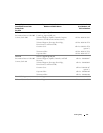
Glossary 161
TOE — TCP/IP Offload Engine. Improves data-transfer
performance over IP networks by allowing the operating
system to offload all TCP/IP traffic to specialized
hardware on the network adapter while leaving TCP/IP
control decisions to the host server.
UNIX — Universal Internet Exchange. UNIX, the
precursor to Linux, is an operating system written in the
C programming language.
uplink port — A port on a network hub or switch used to
connect to other hubs or switches without requiring a
crossover cable.
UPS — Uninterruptible power supply. A battery-powered
unit that automatically supplies power to your system in
the event of an electrical failure.
USB — Universal Serial Bus. A USB connector provides a
single connection point for multiple USB-compliant
devices, such as mice and keyboards. USB devices can be
connected and disconnected while the system is running.
utility — A program used to manage system resources—
memory, disk drives, or printers, for example.
UTP — Unshielded twisted pair. A type of wiring used to
connect systems in a business or home to a telephone line.
V — Volt(s).
VAC — Volt(s) alternating current.
VDC — Volt(s) direct current.
VGA — Video graphics array. VGA and SVGA are video
standards for video adapters with greater resolution and
color display capabilities than previous standards.
video adapter — The logical circuitry that provides (in
combination with the monitor) your system’s video
capabilities. A video adapter may be integrated into the
system board or may be an expansion card that plugs into
an expansion slot.
video driver — A program that allows graphics-mode
application programs and operating systems to display at a
chosen resolution with the desired number of colors.
Video drivers may need to match the video adapter
installed in the system.
video memory — Most VGA and SVGA video adapters
include memory chips in addition to your system’s RAM.
The amount of video memory installed primarily
influences the number of colors that a program can
display (with the appropriate video drivers and monitor
capabilities).
video resolution — Video resolution (800 x 600, for
example) is expressed as the number of pixels across by
the number of pixels up and down. To display a program
at a specific graphics resolution, you must install the
appropriate video drivers and your monitor must support
the resolution.
W — Watt(s).
WH — Watt-hour(s).
win.ini file — A start-up file for the Windows operating
system. When you start Windows, it consults the win.ini
file to determine a variety of options for the Windows
operating environment. The win.ini file also usually
includes sections that contain optional settings for
Windows application programs that are installed on the
hard drive.
Windows 2000 — An integrated and complete Microsoft
Windows operating system that does not require
MS-DOS and that provides advanced operating system
performance, improved ease of use, enhanced workgroup
functionality, and simplified file management and
browsing.
Windows Powered — A Windows operating system
designed for use on NAS systems. For NAS systems, the
Windows Powered operating system is dedicated to file
service for network clients.
Windows Server 2003 — A set of Microsoft software
technologies that enable software integration through the
use of XML Web services. XML Web services are small
reusable applications written in XML that allow data to be
communicated between otherwise unconnected sources.
XML — Extensible Markup Language. XML is a way to
create common information formats and to share both the
format and the data on the World Wide Web, intranets,
and elsewhere.
ZIF — Zero insertion force.


















